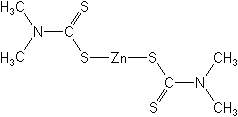-
Common NameZiram
-
中文通用名福美锌
-
IUPACzinc bis(dimethyldithiocarbamate)
-
CAS(T-4)-bis(dimethylcarbamodithioato-κS,κS′)zinc
-
CAS No.137-30-4
-
Molecular FormulaC6H12N2S4Zn
-
Molecular Structure
-
CategoryFungicides > Zinc fungicides
Fungicides > Dithiocarbamate fungicides
Repellents > Bird repellents
Repellents > Mammal Repellents -
Activity
Fungicide, bird repellent, rodent repellent
-
PremixThiram+ziram+urbacide
Thiram+ziram
Chlorothalonil+thiram+ziram
Wettable powder, water dispersible granules, flowable liquid.
-
Physical PropertiesMolecular weight:305.8g/mol;Colourless powder. Melting point:246℃; (tech., 240-244℃);V.p. <1×10-3mPa (extrapolated);KOWlogP = 1.23 (20×)Henry <1.9 Pa m3mol-1S.g./density 1.66 (25℃)Solubility In water 1.58-18.3 mg/l (20℃). In acetone 2.88, methanol 0.22, toluene 2.33, n-hexane 0.07 (all in g/l, 20℃).Stability Hydrolysis DT5018 h (pH 7).
-
Toxicology
Oral Acute oral LD50 for rats 2068, guinea pigs 100-150, rabbits 100-300 mg/kg.Skin and eye Acute percutaneous LD50 for rabbits >2000 mg/kg. Irritating to mucous membranes; highly irritating to eyes; not irritating to skin. Skin sensitiser (guinea pigs).
-
Environmental Profile
Ecotoxicology:
Bees:Not toxic to bees; LD50>100 mg/bee.Birds: LD50< for bobwhite quail 97 mg/kg.Daphnia: EC50(48 h) 0.048 mg/l.Fish: LC50(96 h) for rainbow trout 1.9 mg/l.Worms:LC50(7 d) 190 mg/<ABBR1107 kg soil.
Environmental fate:
Animals:Ziram, orally administered to rats, was mostly eliminated within 1-2 d, leaving 1-2% of the dose in the tissues and carcass after 7 d.Soil:In soil, aerobic DT50 42 h. Unlikely to leach.Plant:The major metabolite in plants is dimethylamine salt of dimethyldithiocarbamic acid; tetramethylthiourea, carbon disulfide and sulfur can also be formed. Dimethyldithiocarbamic acid can be present as the free acid or as the metabolic conversion products, -
Transport InformationHazard Class:III(Slightly hazardous)
Porduct NewsMore
Orthosulfamuron boosts sugarcane production, study finds
Glyphosate price plummets 40% in one year in Argentina
Indian govt stops imports of herbicide Glufosinate priced below Rs 1,289 per kg
Carbendazim fungicide wins victory in Brazilian Parliament
Corteva presents new pre-emergent herbicide Linear for sugarcane in Brazil
Picloram Triclopyr Aminopyralid
Revolutionizing disease prevention: BASF launches new rice fungicide Cevya® in China
Thiamethoxam is allowed again in Brazil by a judicial decision
Bayer develops alternative to glyphosate herbicide
Related CompaniesMore
Hebei Guanlong Agrochemical Co.,Ltd
Country: China
Thiram Ziram Captan Dimethomorph Flusilazole Acetamiprid Iprodione Difenoconazole Prochloraz Azoxystrobin

 0
0 Subscribe
Subscribe
